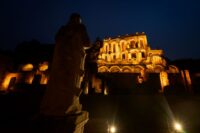 More than 50 years after it was closed due to concerns over its structural integrity, the 1st century Tiberian Palace has reopened to visitors. Millions of tourists have looked up from the Roman Forum to admire the dramatic monumental brick arches on several levels on the slope of the Palatine, but they’ve had to be content to observe from afar as the massive structures were in danger of sliding down the hill.
More than 50 years after it was closed due to concerns over its structural integrity, the 1st century Tiberian Palace has reopened to visitors. Millions of tourists have looked up from the Roman Forum to admire the dramatic monumental brick arches on several levels on the slope of the Palatine, but they’ve had to be content to observe from afar as the massive structures were in danger of sliding down the hill.
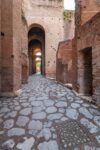 The Domus Tiberiana was the first of the imperial palaces to be planned and constructed as a single comprehensive unit. The palace was built on the northwest corner of the Palatine Hill overlooking the Roman Forum and the Imperial Forum. The imperial residence was only one part of the complex which included gardens, baths, religious sanctuaries, restaurants, service buildings, barracks for the Praetorian Guards and a whole neighborhood of artisans and craftsmen dedicated to the construction and maintenance of the palace.
The Domus Tiberiana was the first of the imperial palaces to be planned and constructed as a single comprehensive unit. The palace was built on the northwest corner of the Palatine Hill overlooking the Roman Forum and the Imperial Forum. The imperial residence was only one part of the complex which included gardens, baths, religious sanctuaries, restaurants, service buildings, barracks for the Praetorian Guards and a whole neighborhood of artisans and craftsmen dedicated to the construction and maintenance of the palace.
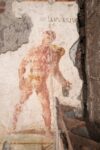 Although named after the emperor Tiberius (r. 14-37 A.D.), it was built by a later Julian-Claudian emperor. The earliest archaeological evidence suggests it was actually Nero who had it built in the aftermath of the great fire of 64 A.D. at the same time he was building his even more extravagant personal residence, the Domus Aurea. It underwent several phases of expansion and reconstruction, most notably under Domitian (81-96 A.D.) and Hadrian (117-138 A.D.). At its largest extent, it covered an area of four hectares.
Although named after the emperor Tiberius (r. 14-37 A.D.), it was built by a later Julian-Claudian emperor. The earliest archaeological evidence suggests it was actually Nero who had it built in the aftermath of the great fire of 64 A.D. at the same time he was building his even more extravagant personal residence, the Domus Aurea. It underwent several phases of expansion and reconstruction, most notably under Domitian (81-96 A.D.) and Hadrian (117-138 A.D.). At its largest extent, it covered an area of four hectares.
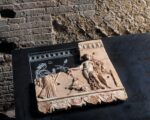 After the end of the Western Empire, the palace remained in sporadic use, administered on behalf of the Byzantine emperor. It was still in such good condition that Pope John VII (r. 705-707 A.D.), whose father had been curator of the Palatine for Emperors Constantine IV and Justinian II, had it restored and used it as his residence. By the 10th century, however, the palace was in ruin and was pillaged for its stone, its prized marbles ground up to make lime. In the late 13th century, the ruins were used for burials.
After the end of the Western Empire, the palace remained in sporadic use, administered on behalf of the Byzantine emperor. It was still in such good condition that Pope John VII (r. 705-707 A.D.), whose father had been curator of the Palatine for Emperors Constantine IV and Justinian II, had it restored and used it as his residence. By the 10th century, however, the palace was in ruin and was pillaged for its stone, its prized marbles ground up to make lime. In the late 13th century, the ruins were used for burials.
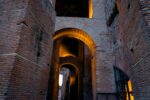 The site was bought by Cardinal Alessandro Farnese in 1550 who filled in the monumental remains and built a splendid pleasure garden, the first private botanical gardens in Europe. He imported rare plants from all over the world and built a wonderland of aviaries, grottos, terraces and staircases rising from what had once been the Forum but for centuries had been grazing pasture for cattle. The cardinal also installed ancient statuary he’d discovered on his properties and acquired from impoverished Roman nobility. The Farnese Gardens became a must-see stop on the Grand Tour.
The site was bought by Cardinal Alessandro Farnese in 1550 who filled in the monumental remains and built a splendid pleasure garden, the first private botanical gardens in Europe. He imported rare plants from all over the world and built a wonderland of aviaries, grottos, terraces and staircases rising from what had once been the Forum but for centuries had been grazing pasture for cattle. The cardinal also installed ancient statuary he’d discovered on his properties and acquired from impoverished Roman nobility. The Farnese Gardens became a must-see stop on the Grand Tour.
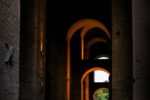 After the demise of the last Farnese of the male line in 1731, the family fortune was inherited by the Bourbon kings of Naples who helped themselves to all the statuary and let the villa and gardens fall into decay. What was left of the gardens was acquired by the newly-unified Italian state in 1870 and the focus shifted to excavating the ancient structures Cardinal Alessandro Farnese had built his terrestrial paradise on top of.
After the demise of the last Farnese of the male line in 1731, the family fortune was inherited by the Bourbon kings of Naples who helped themselves to all the statuary and let the villa and gardens fall into decay. What was left of the gardens was acquired by the newly-unified Italian state in 1870 and the focus shifted to excavating the ancient structures Cardinal Alessandro Farnese had built his terrestrial paradise on top of.
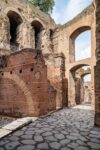 Excavations in the late 19th century uncovered a loggia composed of two rows of arches more than 50 feet high with a marble parapet and rich remains of frescoes and decorative stuccos on the ceiling of interior rooms. Archaeologists at the time attributed this structure to Caligula based on a comment in Suetonius that Caligula built a bridge between the Palatine and Capitoline, but in fact this loggia dates to the reconstruction of the palace under Domitian.
Excavations in the late 19th century uncovered a loggia composed of two rows of arches more than 50 feet high with a marble parapet and rich remains of frescoes and decorative stuccos on the ceiling of interior rooms. Archaeologists at the time attributed this structure to Caligula based on a comment in Suetonius that Caligula built a bridge between the Palatine and Capitoline, but in fact this loggia dates to the reconstruction of the palace under Domitian.
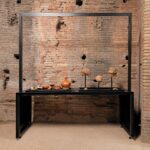 Since the site was closed in 1970, archaeologists have worked to stabilize and restore the palace. Excavations have revealed a more accurate timeline of the site and multidisciplinary studies have combined information from stratigraphy with the findings of the anthropological, faunal and paleobotanical research to shed new light on centuries of life at the Domus Tiberiana.
Since the site was closed in 1970, archaeologists have worked to stabilize and restore the palace. Excavations have revealed a more accurate timeline of the site and multidisciplinary studies have combined information from stratigraphy with the findings of the anthropological, faunal and paleobotanical research to shed new light on centuries of life at the Domus Tiberiana.
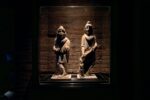 The reopened palace is accessed through the ramp of Domitian, the path trod by the emperor and his entourage to reach his private residence. A new permanent exhibition, Imago Imperi, displays artifacts illustrating the history of the palace in 13 rooms that open along the ramp. Statuary (including the looted head of Pan that was recently repatriated), coins, metal, glass, ceramics and more discovered in decades of excavations at the site showcase how the complex was used over the centuries.
The reopened palace is accessed through the ramp of Domitian, the path trod by the emperor and his entourage to reach his private residence. A new permanent exhibition, Imago Imperi, displays artifacts illustrating the history of the palace in 13 rooms that open along the ramp. Statuary (including the looted head of Pan that was recently repatriated), coins, metal, glass, ceramics and more discovered in decades of excavations at the site showcase how the complex was used over the centuries. 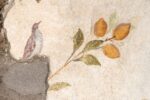 Among the notable new discoveries are three sanctuaries dedicated to different mystery cults (Dionysus, Isis and Mithras) and a fresco from the Augustan era that is the first known representation of a lemon in Italy.
Among the notable new discoveries are three sanctuaries dedicated to different mystery cults (Dionysus, Isis and Mithras) and a fresco from the Augustan era that is the first known representation of a lemon in Italy.